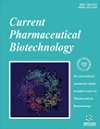- Home
- A-Z Publications
- Current Pharmaceutical Biotechnology
- Previous Issues
- Volume 13, Issue 7, 2012
Current Pharmaceutical Biotechnology - Volume 13, Issue 7, 2012
Volume 13, Issue 7, 2012
-
-
Ultrasound-Induced Blood-Brain Barrier Opening
More LessAuthors: Elisa E. Konofagou, Yao-Sheng Tunga, James Choia, Thomas Deffieuxa, Babak Baseria and Fotios VlachosaOver 4 million U.S. men and women suffer from Alzheimer's disease; 1 million from Parkinson's disease; 350,000 from multiple sclerosis (MS); and 20,000 from amyotrophic lateral sclerosis (ALS). Worldwide, these four diseases account for more than 20 million patients. In addition, aging greatly increases the risk of neurodegenerative disease. Although great progress has been made in recent years toward understanding of these diseases, few effective treatments and no cures are currently available. This is mainly due to the impermeability of the blood-brain barrier (BBB) that allows only 5% of the 7000 small-molecule drugs available to treat only a tiny fraction of these diseases. On the other hand, safe and localized opening of the BBB has been proven to present a significant challenge. Of the methods used for BBB disruption shown to be effective, Focused Ultrasound (FUS), in conjunction with microbubbles, is the only technique that can induce localized BBB opening noninvasively and regionally. FUS may thus have a huge impact in trans-BBB brain drug delivery. The primary objective in this paper is to elucidate the interactions between ultrasound, microbubbles and the local microenvironment during BBB opening with FUS, which are responsible for inducing the BBB disruption. The mechanism of the BBB opening in vivo is monitored through the MRI and passive cavitation detection (PCD), and the safety of BBB disruption is assessed using H&E histology at distinct pressures, pulse lengths and microbubble diameters. It is hereby shown that the BBB can be disrupted safely and transiently under specific acoustic pressures (under 0.45 MPa) and microbubble (diameter under 8 μm) conditions.
-
-
-
Experimental Methods and Transport Models for Drug Delivery Across the Blood-Brain Barrier
More LessThe blood-brain barrier (BBB) is a dynamic barrier essential for maintaining the micro-environment of the brain. Although the special anatomical features of the BBB determine its protective role for the central nervous system (CNS) from blood-born neurotoxins, however, the BBB extremely limits the therapeutic efficacy of drugs into the CNS, which greatly hinders the treatment of major brain diseases. This review summarized the unique structures of the BBB, described a variety of in vivo and in vitro experimental methods for determining the transport properties of the BBB, e.g., the permeability of the BBB to water, ions, and solutes including nutrients, therapeutic agents and drug carriers, and presented newly developed mathematical models which quantitatively correlate the anatomical structures of the BBB with its barrier functions. Finally, on the basis of the experimental observations and the quantitative models, several strategies for drug delivery through the BBB were proposed.
-
-
-
Pharmacokinetics/Pharmacodynamics Model-Supported Early Drug Development
More LessAuthors: Bin Chen, Jennifer Q. Dong, Wei-Jian Pan and Ana RuizPharmacokinetic/pharmacodynamic (PK/PD) modeling & simulation (M&S) provides quantitative assessment of dose/exposure-response relationships with extensive applications at the late stage drug development as well as during regulatory decision making. However, at preclinical and early phase clinical drug development, the importance of PK/PD M&S has not been as widely recognized. We reviewed selected PK/PD M&S literatures in order to convey importance of M&S in these early development phases. We focused on the application of M&S to select and optimize lead candidates, the use of preclinical PK/PD data to project the range of clinical doses, and the development of comprehensive dose/exposure-response models that can be used to forecast the probability of achieving a target response based on Phase 1 safety, PK and biomarker information. We also reviewed several other M&S approaches that are often used in early drug development such as physiologically-based pharmacokinetic (PBPK) modeling, meta-analysis, PK-pharmacogenomics modeling, and etc. Our aims were to provide expert opinions on the practical utility of PK/PD model-based approaches that have positive impact on early decision-making with the goal of improving the success rate of early to late stage drug development.
-
Volumes & issues
-
Volume 26 (2025)
-
Volume 25 (2024)
-
Volume 24 (2023)
-
Volume 23 (2022)
-
Volume 22 (2021)
-
Volume 21 (2020)
-
Volume 20 (2019)
-
Volume 19 (2018)
-
Volume 18 (2017)
-
Volume 17 (2016)
-
Volume 16 (2015)
-
Volume 15 (2014)
-
Volume 14 (2013)
-
Volume 13 (2012)
-
Volume 12 (2011)
-
Volume 11 (2010)
-
Volume 10 (2009)
-
Volume 9 (2008)
-
Volume 8 (2007)
-
Volume 7 (2006)
-
Volume 6 (2005)
-
Volume 5 (2004)
-
Volume 4 (2003)
-
Volume 3 (2002)
-
Volume 2 (2001)
-
Volume 1 (2000)
Most Read This Month


